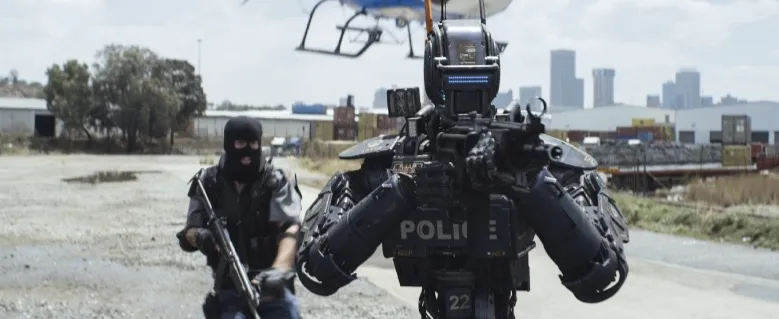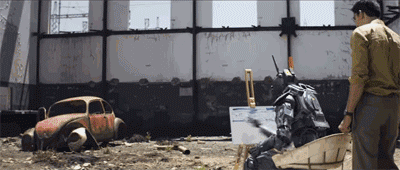Artificial intelligence is already a part of day-to-day life in the modern world. As capable as machines have become, however, we’ve still got some hurdles to overcome before we’ve got the robotic police forces and sentient AI of Neill Blomkamp’s Chappie, which releases this Friday. But maybe, if we look at the advancements humanity has made in machine learning and robotics so far and what it’s done for us, we can get a clearer picture of whether or future will involve harmony with the machines or running in terror.
First, it’s important to consider that robots and AI aren’t necessarily always intertwined. When we write—habitually and extensively—about robots, we have a tendency to frame them in terms of pop culture, which is rife with examples of AI running amok with robotic death machines. However, robots by themselves aren’t generally any more scary than your stereo or your toaster—maybe less depending on your luck with burning yourself on your toaster.
Until we have AI that can think for itself, robots do only what they’re programmed to do and make only the “autonomous” decisions we teach them to make—no matter how many twitter accounts attempt to convince us otherwise.
Why is no one freaking out over the discovery that THERE ARE GIANTS ON MARS WHO HAVE CAPTURED ME?!! pic.twitter.com/7hAibZd4PW
— SarcasticRover (@SarcasticRover) February 18, 2015
That’s also no matter how many robots with rudimentary AI interact with humans and perform important tasks. We already have quite a few of these robots in real life:
Kirobo
Japan’s robot astronaut can carry on conversations, navigate zero-gravity environments, help with science experiments, and strike adorable poses:
Like Chappie, Kirobo has the ability to understand and synthesize speech and can appear to be an actual, thinking robot companion, but he lacks the capacity to, say, decide to get back in a capsule and return to Earth, or rule the International Space Station with an iron (plastic) fist. Since Chappie can do all of that as well as evolve almost immediately to what he’s taught, maybe we could get the two together for a little learning session. Chappie knows all about being cool and could probably help Kirobo step up his pose-striking game.
Asimo

(image via Brian Warren)
Asimo, short for Advanced Step in Innovative MObility, has been in development at Honda since 2000. Over the years its programming has given it a range of capabilities from answering reporter questions (kind of) to stealing your dance moves, but Honda’s main advancement with Asimo has been in creating a humanoid machine with high mobility and dexterity.
Unlike most robots that use wheels or four-legged configurations for ease of movement, Asimo walks on two legs—although not always very well. If we ever want to have robots that get around in a similar manner to us organic meatbags, robots like Asimo will need to work out the kinks in the complex, lightning-quick balance calculations necessary to walk upright so that future robots will be able to effectively strut their stuff and keep it gangster like their human friends.
You’ll also notice that like Kirobo, Asimo is relatively unassuming and even charming like Chappie and his swagger—more than enough to win us over. We might feel differently if they could think for themselves, but when safely programmed only to do what humans want, Asimo is a really impressive and fun piece of technology.
Disney Beachbot and e-David Painting Robot
While we’re on the subject of adorable robots, here’s Disney’s bug-shaped Beachbot drawing in the sand. Of course, it’s really no more than a printer that works on sand, so most artists don’t need to worry that robots are coming for their jobs—well, not this robot, anyway.
e-David, on the other hand, is more than just a printer. Looking at its subjects and taking pictures, this AI is able to devise a unique set of brush strokes to create one-of-a-kind paintings of anything on the fly. You know, like some robots you may have seen…
Robot News Anchors
But here are some robots that are coming for people’s jobs: robot news anchors. Kodomoroid and Otonaroid, which were revealed in an exhibition in Tokyo last year, can report news stories and give us all very Uncanny Valley brain feels in the process. While these two are just prototypes, they do bring up one of the fears that we associate even robots without sophisticated enough AI to bring about judgment day: robots replacing humans in the workforce.
Machines have been taking difficult, tedious, and/or dangerous tasks from human workers since the industrial revolution, but modern robotics are a bit unnerving in the strides that have been made towards allowing machines to do just about anything a human can do, which would make us all a bit superfluous to businesses.
Plus, let’s not forget that the whole Uncanny Valley aspect—where Asimo, Kirobo, and Chappie look different enough from humans to be cute, these two are just straight up unsettling.
And in case you thought they’d always be limited to halting robotic-sounding voices, here’s a synthetic mouth that imitates human speech to fully creep you out:
I’ll take a more machine-like appearance any day, thanks.
Robothespian
Speaking of jobs we thought were safe from robots, there is now a robot actor. You can see Robothespian above delivering his first stand up comedy performance and doing better than most human comedians you’ve probably seen at open mic nights.
But don’t worry, human comedians; maybe Robothespian will give you a job. He still needs writers, because he doesn’t create his own material. He may be able to handle the delivery—and do an even better job of it after his humans analyzed audience reaction in comparison to two human comics he performed with—but coming up with the jokes in the first place is still a human job.
Boston Dynamics, DARPA, and the Robot Army
We’d need more than just a short section in one article to cover all of the robots of Boston Dynamics and DARPA, the Defense Advanced Research Project Agency, and their Karate Kid-mimicking, stair-climbing, cinderblock-hurling antics, but it’s hard to talk about robots without them. In reality, these robots and ones like them are generally more for supporting human military or rescue operations than anything else.
All their kung fu-like balance techniques aim at a simple goal: the ability for machines to move over difficult terrain. Whether that means carrying hundreds of pounds of equipment for human soldiers somewhere that a car or tank couldn’t go, testing protective gear to make sure it works for humans, or scouting out disaster zones to search for survivors, the “robot army” is actually here to help us.
These robots don’t look friendly, but they’re still here for our benefit. Here, have a video of a robot skiing to remind you how cute they can be:
So why are we always so afraid of robots, then? Mostly, it’s because we can imagine all too easily what they’d be capable of in the wrong hands—or no hands at all, as would be the case with AI. Artificial intelligence doesn’t even need a robot body to be the most concerning aspect of robots.
Currently, artificial intelligence, like the robots we’ve been looking at, only does what it’s programmed to do and can only do us harm if we put it in a position to do so without proper safety measures. However, the finish line for AI research would be an artificial intelligence that can think entirely for itself and choose what it wants to do instead of being limited by human coding abilities, which would bring about the singularity—the point where machine intelligence surpasses human intelligence and humans are no longer in control.
Until that point, all we can do is create software that mimics human thought processes and decision making for use under specific circumstances.
Microsoft/Knightscope Security Robots
Microsoft’s Silicon Valley campus recently demonstrated the operation of five Dalek-looking security robots, Knightscope’s K5, that autonomously roam around and radio back to security headquarters when they find something amiss, make loud noises to ward off intruders, and scare the bejeezus out of people, probably. If you want your dystopian future robot police force, here it is, though its resemblance to Chappie is a bit lacking.
Still, they carry out all of their duties, including returning to their charging stations to stay juiced up, by themselves due to their AI. While not altogether incredibly more advanced than your average Roomba, robots that can go about their jobs without human interaction are pretty much the most we can ask for pre-singularity.
Knightscope’s goal for their security bots is to assist human law enforcement instead of replacing it, but it’s easy to see how the same concept with a bit of weaponization could lead to a mostly or fully robotic police force. We’ll just have to wait and see what happens when they put Hugh Jackman in charge.
Mostly, robots tend to be non-threatening, useful tools just like any other machine, and a lot of them can be pretty entertaining to interact with. However, if the kind of advanced robots currently in development were controlled by a malevolent AI, they could easily go from a benefit to humanity to our own undoing. Luckily, we’ve got some time to plan before today’s AI is advanced enough to make that happen.
For now, we’ve got nothing to be afraid of from machines or AI directly no matter what concerns we might have—or jokes we might make—to the contrary. Like in Chappie—where the human-controlled robot police are the villains and the autonomous AI winds up being the hero—robots and AI are neither inherently good nor evil. Our main concern should be making sure that humans use technology responsibly for the good of everyone and teach AI to do the same.
For Chappie tickets, clips, and information, check out Fandango.
Are you following The Mary Sue on Twitter, Facebook, Tumblr, Pinterest, & Google +?












Published: Mar 2, 2015 10:11 am